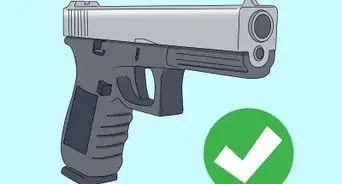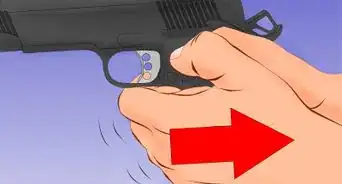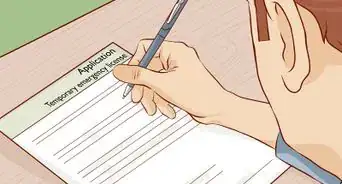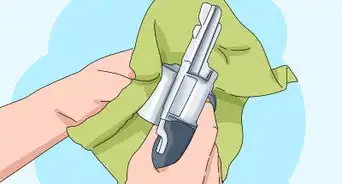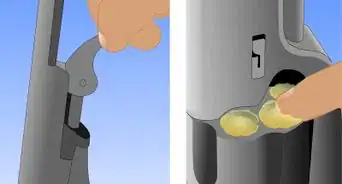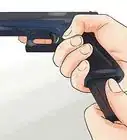This article was co-authored by Bryan Villella. Bryan Villella is the Lead Firearms Instructor and Owner of Don't Be A Sitting Duck in Kissimmee, Florida. Bryan has nine years of professional experience and is an NRA and Florida State Certified “K” Instructor. He leads certified training courses necessary to get licensed through the state to work in the private security field. He prioritizes safety and building comfortable environments for people to learn skills safely.
This article has been viewed 112,197 times.
Point-shooting is the skill that matches the direction you think you are pointing a handgun, to where it is actually pointing. This is a very controversial issue, and the vast majority of professional trainers encourage flash sighting as it is many times more accurate, and is only a small fraction of a second slower. Point-shooting has a very applicable place even for those who do not directly advocate it. Ultra-close combat situations, where the target is within arm's reach, sighted shooting has no place.
Steps
The Basics
Point-shooting is actually describing the ability for a shooter to be able to shoot a target without aiming with the sights. This is done relatively easy if you have a gun that fits you well and are at very close range.
-
1Choose a pistol that fits you well, and has the attributes you want in a sidearm. Determine basic point-shoot capabilities of the gun. With an unloaded gun, close your eyes and point the gun in a safe direction with your finger next to the trigger, but not on it, at a makeshift target. Imagine pointing the barrel of the gun directly at the target. Open your eyes — the sights should be lined up exactly where you wanted it. At five yards, it should be no more than a couple inches off center-target.
- If the handgun is pointing high or low, this can be compensated for with practice. For example, almost everyone who has never used a Glock before has a high point-shoot location by 6–10 inches (15.2–25.4 cm) at five yards. But with practice, you will find that you can compensate for that quickly.
- If you then pick up a better-fit gun, you will find that it will point low. If the point is too far off, you might want to consider a different handgun.
- Side-to-side point-shoot inaccuracy may be a matter of grip or design of the pistol. You may need to try a rubber grip, different back strap, or larger or smaller pistol.
-
2Use point-shooting only at very close range, as the best known "tactically minded" shooters strongly encourage flash sighting beyond a couple yards. But there is no sense in not trying to hone every skill in your bag of tricks.
Drills
Some drills to help your point-shooting skills. The best way to optimize your unsighted ability is to quickly adapt to where bullets are landing (if it lands high or left, adjust your point accordingly for follow up shots). Adapt these drills, and practice as many of these as you can from the close contact position, as this will be the most likely use of such a skill. As these are close quarters combat drills, multiple follow up shots are encouraged and rapid fire practice is a beneficial skill as well.
-
1Position yourself 3-yards away from a large (10+ inch) target. In a lowered gun stance (safe-carry position), pull your gun up, as quickly as possible, to firing position and fire multiple shots into the target. Do not use your sights! This drill is to get you less dependent on your sights.
- It may take quite a few tries, but you will find you eventually can place that bullet near the center of your target every time.
- The key is to try to perform it quickly, but try to take just enough time to allow the momentum of your arms and gun to slow as you get to the target.
- Attempt to stretch your abilities by increasing the distance to the target, or decreasing the time you have to fire. Try to get good hits. A slow hit is always better than a fast miss.
-
2Practice with multiple targets. You want to start by setting up three or more targets a yard or two apart. Quick to firing position and go down the line. One shot at each target.
- Change it up: fire a burst at each target; maybe try in a different order; have a friend tell you which one to shoot ("one!", "three!", etc.), but the key thing to be sure of is that you hit your target; once you are sure you can hit your target every time, try to accelerate your pace.
- Try it from the close contact position at 3- then 5-yards. See how quickly you can change between targets and how many bullets land in "good hit" zones.
-
3Practice while moving. While moving, you should still be able to hit targets at 5-yards. Set up three or more targets a few yards apart from each other. Start about 15–18 yards (13.7–16.5 m) back. Run up to about 5-yards (from your first target) while drawing your gun to firing position. Fire a two-shot burst, side-step to engage the next target, and so on.
- Each time you run the course, try to do it faster; try not to pause when shooting, but remember that doing so will likely make you much more accurate.
- Try drawing when 3- or 5-yards away from the first target. Once you have landed good hits on the first target sidestep and move down the line of targets.
Warnings
- All practicing should be done at the shooting range obeying all safety rules, or in a legal and private location with an unloaded gun (or you can replace the rounds with snap-caps).⧼thumbs_response⧽
- Be sure to know what is down range. Bullets can travel for miles or can bounce and ricochet into unintended directions.⧼thumbs_response⧽
- When the range is closed, take the ammo magazine out of your weapon, make sure there is no bullet in the chamber (hold the slide back to check), turn the safety on, and set the weapon down in a safe location.⧼thumbs_response⧽
- Any firearm should only be shot in a safe and legal location. Be aware of state and local laws on use and transportation of a firearm and follow them carefully. Laws change drastically between states and can change between counties or even cities.⧼thumbs_response⧽
- Practice with pellet guns then rubber/wax bullets, do not use real bullets until you are comfortable with your weapon and can handle the recoil.⧼thumbs_response⧽
- If you are shooting at an unofficial range (make sure it is still legal, like at Giant Rock, CA) scout out the area to make sure there are no people down range.⧼thumbs_response⧽
- A pistol can inflict serious injury or even death. Be sure to always point the pistol in a safe direction and never point it at something you do not intend to shoot.⧼thumbs_response⧽
- Make sure your weapon is registered and legal, especially for handguns.⧼thumbs_response⧽
- Safety first! Firearms are very dangerous. Only use a pistol or other firearm if you are an experienced shooter or have a very experienced shooter directly supervising you.⧼thumbs_response⧽
-Step-1-Version-3.webp)
-Step-2-Version-3.webp)
-Step-3-Version-3.webp)
-Step-4-Version-2.webp)
-Step-5-Version-3.webp)

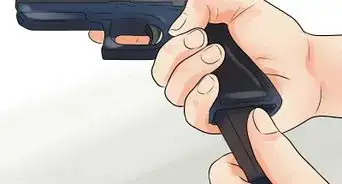

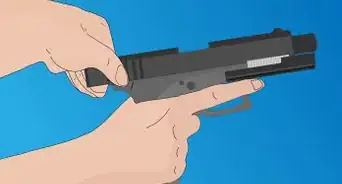
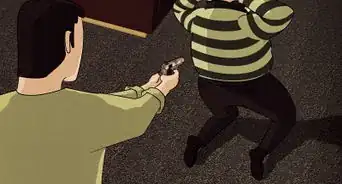
-Step-21-Version-3.webp)
